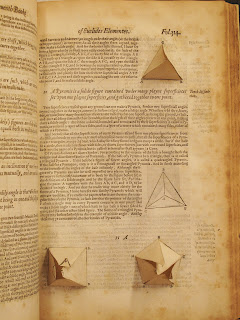While many people develop a kind of nervous tick at the mention of geometry, flashing back to the schoolhouse frustrations typically associated with maths, the geometry classroom, above all others, was enormously creative for me. I was a disastrous student in general but in mathematical subjects I experienced a natural fluency, one that was tested when I entered tenth grade geometry. Frustrated with my incompetent teacher and my resulting grades, I took to reading the text book rather than paying attention in class. My grades and comprehension quickly improved and it soon became apparent that in geometry I had found my life's metier. I also discovered the method by which I would pursue any future studies: reading books and drawing. Since that first brush with geometry I have used what I learned in that text book to draw letters, design books, develop ornaments and patterns—all of the things that I love most to do.
My method for working on Thirteen Propositions is similar to my method in the tenth grade. I am beginning by reading and drawing proofs for all the propositions in Euclid's thirteen books. Along the way, certain propositions stand out as having a particular interest or relevance: they spark associations in literature, letter forms, or life (or all three). I then begin to develop visual ideas, write bits of text, and begin reading other books that might inspire or relate to the proposition at hand. My thought at this point is that each proposition will involve a work of Greek literature but it is too early to tell if that will be the case. While some of the reading is great fun, the Iliad, David Copperfield, Edith Hamilton, Euclid, etc., some is less thrilling. Just a few days ago I received a copy of a ninth grade algebra text book that sent strange shivers through my body, an uncomfortable electrical current connecting me with my awkward thirteen year old self. Thankfully, I am able to read through a chapter a day, meaning that it will be a quick torture. There are only fourteen chapters.
Simultaneously with these studies, I am conducting a survey of a few hundred editions of Euclid, beginning with Erhardt Ratdolt's edition of 1482 and ending with editions from the last few years. For those of you who are unfamiliar with the structure of the Elements, there are thirteen books comprising roughly twenty to fifty propositions. Each of the propositions begins with an enunciation of what is meant to be proven, followed by the proof and conclusion which are illustrated by a line diagram. These diagrams have remained constant for hundreds of years and so it is interesting to see how designers and printers have tried to distinguish their edition from others—you can tell instantly if the printer had fun with geometry or took it a little too seriously. Below I've attached just two examples. The first is from Paganius Paganinus' 1509 edition edited by Fra Luca Pacioli and it is pretty much exactly what one would expect from a Humanistic friar: tall slender columns of uninterupted text with the squares, trapezia, etc. tucked safely in the margins. The second is published by John Daye in London in 1590, showing his lovely little pull-up illustrations from Book XI. Daye's is closer to the spirit which I will try to evoke in my edition.






